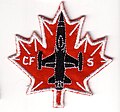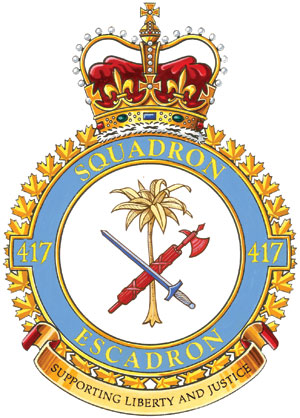
417 Combat Support Squadron is an Air Force unit with the Canadian Forces. Based at CFB Cold Lake it provides helicopter support to the base operations. Since 1994, it has also provided search and rescue.

Canadian Forces Base Greenwood, or CFB Greenwood, is a Canadian Forces Base located 1.5 nautical miles east of Greenwood, Nova Scotia. It is primarily operated as an air force base by the Royal Canadian Air Force and is one of two bases in the country using the CP-140 Aurora and CP-140A Arcturus anti-submarine/maritime patrol and surveillance aircraft. Its primary RCAF lodger unit is 14 Wing, commonly referred to as 14 Wing Greenwood.

408 Tactical Helicopter Squadron is a unit of 1 Wing, Kingston. It is co-located with 1 Canadian Mechanized Brigade Group at Canadian Forces Base (CFB) Edmonton.

No. 420 "City of London" Squadron RCAF was a squadron of the Royal Canadian Air Force (RCAF) which existed from late December 1941 forwards. The Squadron's nickname was "Snowy Owl". Their motto was Pugnamus Finitum, Latin for We Fight To The Finish. No. 420 Squadron is no longer active.

419 Tactical Fighter Training Squadron is a unit of the Royal Canadian Air Force. The squadron was originally formed during the Second World War and is currently based at CFB Cold Lake. It is responsible for advanced tactical fighter training for pilots of the RCAF and as part of the NATO Flying Training in Canada (NFTC) program using nine CT-155 Hawk trainers.

409 Tactical Fighter Squadron is a unit of the Royal Canadian Air Force. The squadron operates the CF-18 Hornet from CFB Cold Lake in Alberta, Canada.

413 Transport and Rescue Squadron is an air force squadron of the Canadian Armed Forces. It was originally a flying boat squadron of the Royal Canadian Air Force during the Second World War. It currently operates the C-130 Hercules and the CH-149 Cormorant in transport plus search and rescue roles at CFB Greenwood.
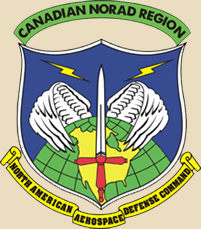
Canadian Forces Base Winnipeg is a Royal Canadian Air Force base located within the City of Winnipeg, Manitoba. Co-located at the Winnipeg James Armstrong Richardson International Airport, CFB Winnipeg is home to many flight operations support divisions, as well as several training schools. Its primary RCAF lodger unit is 17 Wing, commonly referred to as 17 Wing Winnipeg.

414 Electronic Warfare Support Squadron is a unit of the Royal Canadian Air Force. It is located in Ottawa and conducts electronic warfare support training for other units in the Canadian Armed Forces.

403 "City of Calgary" (Helicopter) Operational Training Squadron is a squadron of the Royal Canadian Air Force (RCAF) located at Canadian Forces Base Gagetown. It is equipped with CH-146 Griffons and provides operational aircrew training to the crews who will fly the helicopter. The squadron also conducts operational test and evaluation, develops aviation tactics and carries out operations in support of the 1 Wing mission. It also supports the local Army requirements of the Combat Training Centre. It was founded as No. 403 Squadron RCAF.

427 Special Operations Aviation Squadron is a tactical helicopter unit that provides aviation support to Canadian Special Operations Forces Command. The squadron is based at CFB Petawawa, Ontario with a fleet of Bell CH-146 Griffon helicopters. It was founded during the Second World War as No. 427 Squadron RCAF.

No. 428 Squadron RCAF, also known as 428 Bomber Squadron, and 428 Ghost Squadron, was first a night bomber squadron of the Royal Canadian Air Force engaged in strategic bombing during World War II, based in Yorkshire. At the end of the war the squadron moved to Nova Scotia before being disbanded in September 1945. In 1954 the squadron was reformed as 428 All-Weather (Fighter) Squadron, before being again disbanded in 1961.
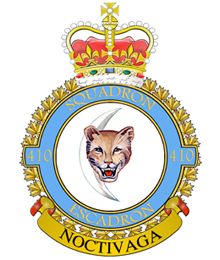
410 Tactical Fighter Operational Training Squadron, nicknamed the "Cougars", is a Royal Canadian Air Force aircraft squadron currently located at Canada's primary training base for the CF-18, at Cold Lake, Alberta. The squadron was formed during the Second World War as an RCAF squadron under the Royal Air Force (RAF), at RAF Ayr, near Prestwick, in Scotland.

416 "City of Oshawa" Tactical Fighter Squadron was a unit of the Canadian Forces and the Royal Canadian Air Force. The squadron operated the CF-18 Hornet fighter jet from CFB Cold Lake in Alberta, Canada. In 2006, 416 TFS stood down and was amalgamated with 441 Tactical Fighter Squadron to form 409 Tactical Fighter Squadron.

426 Transport Training Squadron is a unit of the Canadian Forces under Royal Canadian Air Force, located at CFB Trenton in Trenton, Ontario. It originated as a squadron in the Royal Canadian Air Force (RCAF) that fought during the Second World War as a bomber squadron.

425 Tactical Fighter Squadron (French: 425e Escadron d'appui tactique, also "Alouette" Squadron, is a unit of the Royal Canadian Air Force. It operates CF-18 Hornet fighter jets from CFB Bagotville in Quebec, Canada. The squadron was originally formed during the Second World War.

No. 421 Squadron RCAF was a unit of the Royal Canadian Air Force. It was the last RCAF fighter squadron to be formed in the UK during World War II.

430 Tactical Helicopter Squadron is a unit of the Canadian Forces under the Royal Canadian Air Force. It operates Bell CH-146 Griffons from CFB Valcartier, near Quebec City in Quebec, Canada.

433 Squadron is a unit of the Royal Canadian Air Force. It operates CF-18 Hornet fighter jets from CFB Bagotville in Quebec, Canada. Its Commanding Officer is Lieutenant Colonel Tom "Banger" Lawrence.
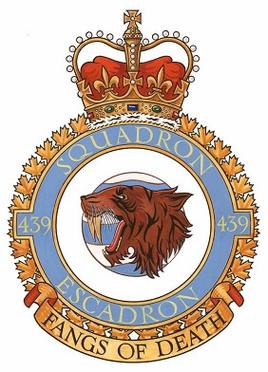
439 Combat Support Squadron is a squadron of the Royal Canadian Air Force, based in Bagotville, Quebec.



